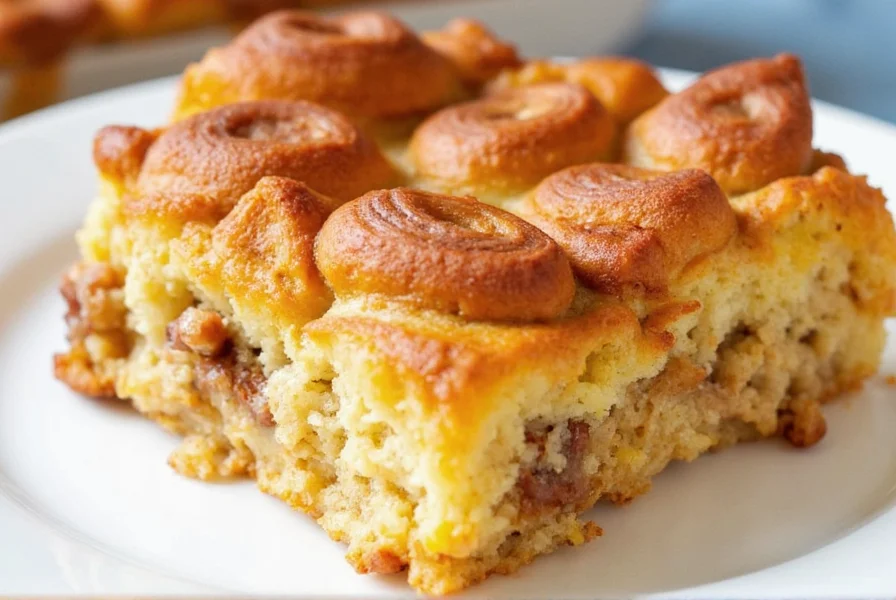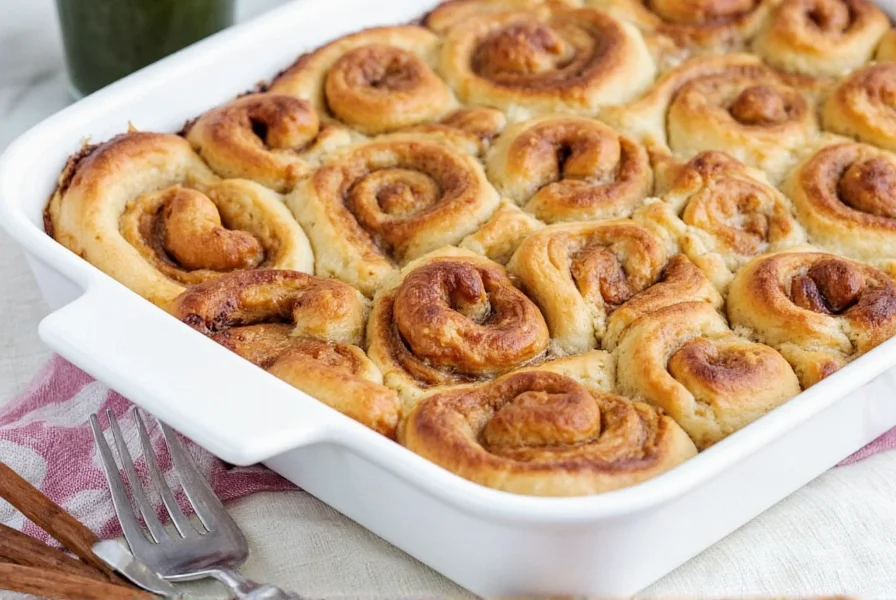If you're searching for a crowd-pleasing breakfast that feels special but requires minimal effort, this cinnamon roll casserole recipe delivers. Unlike traditional cinnamon rolls that require rolling and shaping individual portions, this breakfast casserole transforms store-bought or homemade cinnamon roll dough into a single-bake dish perfect for holidays, brunch gatherings, or weekend mornings.
Why This Cinnamon Roll Breakfast Casserole Works
What makes this particular cinnamon roll casserole recipe stand out from others? The magic happens through strategic layering. Instead of simply arranging pre-formed rolls in a dish, you separate the dough into individual pieces, then layer them with a rich butter-cinnamon-sugar mixture and toasted pecans (optional but recommended). This technique creates multiple crispy edges and ensures every bite contains that perfect balance of sweet, buttery, and cinnamon flavors.
Essential Ingredients for the Best Cinnamon Roll Casserole
The beauty of this easy cinnamon roll casserole recipe lies in its simplicity, but each ingredient serves a specific purpose:
| Ingredient | Why It Matters | Substitution Options |
|---|---|---|
| Refrigerated cinnamon roll dough (3-4 cans) | Provides consistent texture and flavor base; saves significant preparation time | Homemade cinnamon roll dough (yielding similar quantity) |
| Unsalted butter (1 cup, melted) | Creates rich flavor and helps cinnamon mixture adhere to dough | Vegetable oil or coconut oil (may alter flavor profile) |
| Brown sugar (1 cup, packed) | Adds deep caramel notes that complement cinnamon | Granulated sugar (less complex flavor) |
| Cinnamon (2 tablespoons) | Essential spice that defines the flavor profile | None (not recommended as it changes the fundamental character) |
| Pecans (1 cup, chopped) | Provides texture contrast and nutty flavor that enhances sweetness | Walnuts or omit for nut-free version |

Step-by-Step Preparation Guide
Follow these detailed instructions for a perfect cinnamon roll breakfast casserole every time:
- Preheat and prepare: Set your oven to 350°F (175°C) and generously grease a 9x13-inch baking dish with butter or non-stick spray.
- Prepare the cinnamon mixture: In a medium bowl, combine melted butter, brown sugar, cinnamon, and salt. Whisk until smooth and well incorporated.
- Layer the dough: Separate cinnamon roll dough into individual pieces. Dip each piece into the cinnamon mixture, ensuring full coverage, then arrange in the prepared baking dish. Sprinkle chopped pecans between layers for even distribution.
- Rest the casserole: Let the assembled casserole sit at room temperature for 15-20 minutes. This resting period allows the dough to slightly rise and absorb the flavors.
- Bake to perfection: Place in preheated oven and bake for 28-32 minutes, until the center tests done and the top has turned a rich golden brown. Avoid underbaking, as the center must fully cook through.
- Prepare the glaze: While the casserole bakes, make your glaze by combining powdered sugar, softened cream cheese, milk, and vanilla extract until smooth.
- Finish and serve: Immediately after removing from oven, drizzle warm casserole with glaze. Allow to cool for 5-7 minutes before serving to let the glaze set slightly.
Pro Tips for Cinnamon Roll Casserole Success
Professional bakers rely on these techniques to elevate their cinnamon roll casserole recipe:
- Dough temperature matters: Work with refrigerated but not cold dough. If dough is too cold, it becomes difficult to separate and handle.
- Don't skip the rest period: Allowing the assembled casserole to rest before baking improves texture and ensures even cooking.
- Check doneness properly: Insert a toothpick into the center—it should come out clean with no uncooked dough clinging to it.
- Glaze while warm: Applying the glaze to the warm casserole (not hot) allows it to absorb some flavor while still setting into a beautiful finish.
- Use quality ingredients: The limited ingredient list means each component shines, so choose good quality cinnamon and fresh dairy products.
Variations to Customize Your Breakfast Casserole
Once you've mastered the basic cinnamon roll casserole recipe, try these popular variations:
- Cream cheese swirl version: Before baking, dollop small amounts of sweetened cream cheese between the dough layers for surprise pockets of tangy richness.
- Apple cinnamon twist: Add 1½ cups of thinly sliced, peeled apples between layers for a delightful fruit addition that complements the cinnamon flavor.
- Overnight cinnamon roll casserole: Assemble the casserole the night before, cover tightly, and refrigerate. Bake straight from the refrigerator, adding 5-8 minutes to the baking time.
- Gluten-free adaptation: Use gluten-free cinnamon roll dough and ensure all other ingredients are certified gluten-free for those with dietary restrictions.
Serving and Storage Recommendations
This breakfast casserole serves 8-10 people and pairs beautifully with fresh fruit, scrambled eggs, or bacon for a complete brunch spread. For best results:
- Serving temperature: Enjoy warm, within 2-3 hours of baking for optimal texture and flavor.
- Short-term storage: Keep leftovers covered at room temperature for up to 24 hours or refrigerate for 3-4 days.
- Reheating method: Warm individual portions in the microwave for 20-30 seconds or cover the entire dish with foil and warm in a 300°F oven for 10-15 minutes.
- Freezing option: Freeze unbaked casserole for up to 3 months. Thaw overnight in refrigerator before baking as directed.
Troubleshooting Common Issues
Even experienced bakers encounter challenges with cinnamon roll casserole recipes. Here's how to solve frequent problems:
- Soggy center: This usually indicates underbaking. Next time, increase baking time by 3-5 minutes and ensure your oven temperature is accurate with an oven thermometer.
- Dry texture: Overbaking causes dryness. Reduce baking time by 2-3 minutes and check for doneness starting at 25 minutes.
- Glaze too runny: Use less milk in your glaze mixture or let the casserole cool for 5 minutes before applying the glaze.
- Sticking to pan: Always grease the baking dish thoroughly, and consider lining with parchment paper for easy removal.
Why This Recipe Deserves a Place in Your Collection
This cinnamon roll casserole recipe stands out because it delivers restaurant-quality results with minimal effort. The strategic layering technique creates more surface area for that perfect crispy edge texture while maintaining a tender interior. Unlike simpler dump-and-bake versions, this method ensures every bite contains the ideal ratio of dough to cinnamon filling. Whether you're feeding a crowd for holiday brunch or treating yourself to a special weekend breakfast, this reliable recipe consistently delivers the comforting flavors of traditional cinnamon rolls with significantly less work.
Frequently Asked Questions
Can I make cinnamon roll casserole ahead of time?
Yes, you can prepare cinnamon roll casserole the night before. Assemble the casserole in the baking dish, cover tightly with plastic wrap, and refrigerate for up to 12 hours. When ready to bake, remove from refrigerator while preheating oven, then bake as directed, adding 5-8 minutes to the baking time since it's starting cold.
What's the best way to reheat leftover cinnamon roll casserole?
For best results, reheat individual portions in the microwave for 20-30 seconds. For larger portions or the entire casserole, cover with foil and warm in a 300°F oven for 10-15 minutes. Avoid overheating as this can make the casserole dry. Add a small pat of butter on top before reheating for extra moisture.
Can I use homemade cinnamon roll dough for this casserole recipe?
Absolutely. This cinnamon roll casserole recipe works equally well with homemade dough. Prepare your favorite cinnamon roll dough recipe, roll out, spread with butter, cinnamon and sugar, roll up, and cut into 1-inch slices. Layer in the baking dish following the same instructions. You'll need enough dough to yield approximately 24-30 individual roll pieces.
Why did my cinnamon roll casserole turn out dry?
Dry cinnamon roll casserole typically results from overbaking or using dough that's too old. Check your oven temperature with an oven thermometer to ensure accuracy, and start checking for doneness at 25 minutes. The center should be set but still slightly soft to the touch. Using fresh dough (check expiration dates) also prevents dryness. Adding an extra tablespoon of melted butter to the cinnamon mixture can help maintain moisture.
How many people does a standard cinnamon roll casserole serve?
A standard 9x13-inch cinnamon roll casserole made with 3-4 cans of refrigerated dough typically serves 8-10 people as a main breakfast item. If serving as part of a larger brunch spread with other dishes, it can comfortably serve up to 12 people. The casserole should be cut into 2x2 inch squares for standard portions.











 浙公网安备
33010002000092号
浙公网安备
33010002000092号 浙B2-20120091-4
浙B2-20120091-4